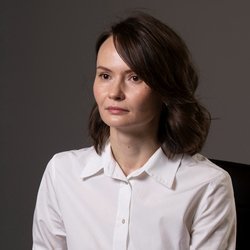Natalia Malykh: ‘The stock market has withstood the blow, though with losses’
Analyst of Finam FG — about a reduction of securities market in Russia and its important changes
It is important to develop both demand and supply in the Russian securities market now, according to head of the Central Bank Elvira Nabiullina. In the meantime, businesses do not actively use securities as a financing tool. Restoring the confidence of private investors, lost after the turmoil of this year, will help to support demand. Nevertheless, despite a reduction in volumes and transformation, the Russian capital market has withstood the blow, Natalia Malykh, an analyst at Finam Financial Group, notes in the author's column for Realnoe Vremya.
After 8 months, we can say that the securities market in Russia has decreased in volume and changed according to important criteria (dividends, the composition of investors, etc.), but withstood the blow. The bond market is showing a stronger recovery due to lower risks and the past cycle of rate cuts, both in the secondary segment and in the primary one. There is less confidence in stocks, and the dynamics of the Moscow Exchange index is mainly determined by the agenda for he special military operation, and the inflow/outflow to the market is unstable. At the same time, preference is given to large companies, including those with state capital, which have stable financing and market share.

Dynamics of investments in the capital market
Monthly exchange data of the Moscow Exchange indicate a moderate decrease in the total trading volume after the peak level in March. In September, the trading volume on all sites was by 15% lower than in January 2022 and 17% lower than in September 2021. At the same time, the dynamics of individual sites may vary greatly. The money market remains the most stable (+24% to January and +1% YoY), but the stock market has suffered greatly (-41% to January and -32% YoY) due to stocks (-65% to January and -48% YoY).
Investors are cautious about investing in stocks due to uncertainty with their own, and the dynamics of the Moscow Exchange index is mainly determined by the news agenda.
In the summer, investors began to return to the stock market against the background of a relative lull in Ukraine, and by September the inflow into mutual funds had reached an annual maximum, although mostly these funds were allocated to bond funds.
Investments in stocks, in turn, are unstable, despite low interest rates. In addition to the geopolitical factor, investors' confidence was affected by the refusal of most major issuers to pay dividends and sanctions.
Judging by the “people's portfolio”, preference is given to the largest companies (Moscow Exchange's data for September), often with state capital, which, if necessary, will have access to financing (including state), there is a scale of business and a significant market share in Russia and abroad. In the sectoral context, the oil and gas sector dominates, which is less susceptible to sanctions and can serve as a proxy for the dollar when the ruble weakens due to the presence of export earnings.
The current conditions are not an ordinary economic crisis, but the transformation of the economy that is going along with the military conflict. Therefore, it is quite natural that investors are not showing much appetite for risk. Stocks are a risky product, and many companies now do not pay dividends and limit the disclosure of operational and financial statements. In the capital market, preference is given to low-risk products such as bonds and deposits in banks, even despite low interest rates.
Investors have more confidence in the bond market than in stocks, largely due to lower risks and the past cycle of lowering the Central Bank's key interest rate. At the same time, there is demand both in the secondary bond market and new placements.
We see the following drivers as key factors for the stock market in the long term:
The end of the special military operation in favour of Russia with the accompanying deepening of trade and economic ties with BRICS+ and SCO partners who may be interested in cheap Russian assets. This will be facilitated by the introduction of cross-border digital payments of various kinds, which the US will not be able to track, and correspondingly, impose secondary sanctions. The main motivation for investing in our assets is doubts about the reliability of investments in the United States after anti-Russian sanctions and the blocking of gold reserves. Net exporters, such as Russia, China and Saudi Arabia, invested surplus funds in US government bonds. China has been reducing its investments in treasuries for a long time due to strained relations with the United States. Saudi Arabia is also likely to look for other options to place its funds, not only because of soured relations with the United States, but also the risk of an explosion in the bond market of developed countries.
At the initial stage, these are likely to be direct investments and only then portfolio investments. But this can happen only after the strengthening of Russia's position in the conflict.
The return of “unfriendly” investors under the guise of “friendly”. In mid-October, Deputy Finance Minister Aleksey Moiseev said that “unfriendly” investors are trying to “buy Russian assets on the cheap in the West and sell them more expensive in Russia” and “are interested in the market and are looking for ways to enter the Russian market. This is already obviously happening.” According to the Moscow Exchange, as of January 2022, non-residents accounted for 49% of the trading turnover.
Reference
The author's opinion may not coincide with the position of the editorial board of Realnoe Vremya.